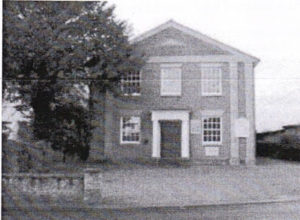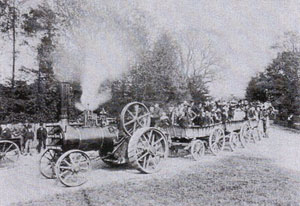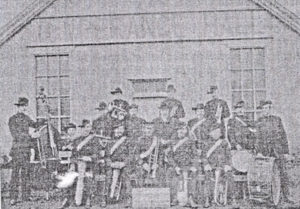The Congregational Church

These are notes, found by John Warby, regarding the history of the chapel written on scrap paper by Mr. Wilfrid Nunn, in the 1950s.
‘Wilfrid’ is how he spelt his name and how it is inscribed on his gravestone. It is an Anglo-Saxon spelling.
‘The chapel is situated in the Main Street of Walsham le Willows, east of John Proctor’s property (in 885), (May Villa), and west of Philip Youngman’s property (in 1857), (The Limes), with both the properties abutting on to the chapel area.
This building was erected circa 1851. (Recent research shows the building of the chapel started in 1844.) It was built by a denomination called Wesleyans and carried on under trustees till appoximately 1851 when an action by the Wesleyan Conference caused great confusion, not only here but throughout England. Three ministers were dismissed on what was apparently a trivial matter. It was estimated that 30,000 members left the denomination at that period. It appears that a residue tried to carry on, but by 1857 they were in debt and the trustees tendered their resignation.
John Youngman, a butcher and farmer of Winfarthing wrote to the Rev. Beecham, in charge of the annual Wesleyan Conference, for permission to sell the premises. This application was ignored by the leaders of the body and so J. Youngman applied to Mr. H, Wilkinson, of Walsham Hall and a Justice of the Peace, for confirmation of his appeal which Mr. Wilkinson duly signed.’
It appears that John Youngman advanced money on loan to the Independant or Congregational Church and there was an amalgamation of chapels including Walsham, Wattisfield, (bought for £380), and Botesdale, (for £250). Also acquired was a building called Dyer’s School in Botesdale, and a chapel in Blo’ Norton. Wilfrid Nunn mentions that Wattisfield was one of the first free churches in Suffolk, built originally in 1654 (rebuilt in 1876 at a cost of about £1,500), and that Botesdale was illuminated with gas supplied by the local gas works.
The chapels were managed by the same minister with assistance of a second minister. The Rev. Wm. Warren probably was the most able man in their history, he being minister, solicitor, guardian, protector, and helper to many, when most were illiterate and dim about how to manage their own business. Mr. Warren finally retired in 1888 and lived in hired rooms at Wattisfield Hall, an Elizabethan building. He died on Sunday night August 26th 1900 aged 87, after being a minister here for 42 years.’ The Walsham Chapel had originally a barrel organ to supply the music but when St Mary’s parish church was presented with a new organ in about 1870 the old one was sold to the Congregational Chapel. Wilfrid Numm writes: ‘How my grandfather tuned his bass fiddle to correspond to the key of B on the organ is beyond my comprehension. In our own day three generations of the family sat side by side, each with a musical instrument. For many years my mother played the number 2 organ. About the time of the War in 1914 one member of the family began to assemble a new organ, of which the existing number 3 organ contains much of what he bought. Owing to the war and his early death the organ was finally assembled by an Ipswich firm.# (The family member must have been Wilfrid’s brother Frank who died of pneumonia in 1917.)
Wilfrid continues:
‘In writing the somewhat brief details of the Congregational Chapel we are greatly in debt to a man named Josiah Jaggard, a familiar and common name in Walsham down to 1943 but now i.e. 1953, none by name or relation left. This man is indirectly connected with the family and a great friend in his time. He spent all his adult life in Queensland, Australia living to the age of 91. He was connected to another numerous Walsham family named Youngman and we have endeavoured to set out the connection so that it can be ascertained. A Thomas Youngman owned a small holding some 100 yards east of the village pound. He had a brother John Youngman, a butcher, and another brother Beljamin, a butcher at Botesdale. Thomas was left a widower early in life with two daughters Fanny and Caroline. He later married the widowed mother of Josiah Jaggard and by this second marriage was born a son, Thomas Willioam Youngman, half brother to Josiah, and grandfather to me, Wilfrid Nunn.’
This may not be totally accurate. Records suggest that Thomas Youngman Senior died in 1830 and his widowed wife married Robert Jaggard in 1833. The 1841 census shows young Thomas Youngman living with the Jaggard family with his younger half brother, Josiah Jaggard. I might be wrong – it needs further research.
James Turner
The Temperance Society

The Nunns and the Youngmans were also involved in the formation of the Walsham Temperance Society. An article in the Bury Free Press in March 1930 gives information about the beginnings of this once influential movement. The local Temperance Society was formed in Walsham in December 1882 with Mr. H. Nunn holding the position of Hon. Secretary. It stated at a time when Temperance work was unpopular. The workers were often the object or ridicule. However the Society became successful and in the first 50 years almost 1,250 names had signed the pledge book promising to abstain from drinking alcohol.

The Society started in Walsham with a meeting in the Infant School. The building had been placed at the Society’s disposal by the late Mrs. Lucy Martineau who rendered valuable help in its early years. Meetings were also held at the Mill Barn which was a great draw, being lit by 100 candles. Opponents ofthe Society who interrupted the meetings, often helped by drawing a bigger crowd, and making the event more interesting. In subsequent years valuable help came from Bishop T .E. Wilkinson of the established church, Mr. W. Clamp, Mr. Wm. Youngman, and Mr. W. Stevens who later went to New Zealand. A need was felt for a new building for meetings. In June 1902 the Temperance Hall, accommodating about 150 people, was opened on land owned by Harry Nunn.’
James Turner
A Gravestone from 1812
Recent pruning in the churchyard has revealed a double tombstone, obscured for many years by a large ornamental shrub opposite the church porch. The lettering is well-cut and for the most part perfectly legible after two hundred years. The stone commemorates William Youngman, another member of the well-known Walsham family. He died 25 January 1812 aged 56, and his wife Sarah, commemorated with him, died 4 June 1817 aged 59. At the base of the stone is a text which we have transcribed for ease of reading:
The righteous live for evermore; their reward also is with the Lord, therefore shall they receive a glorious kingdom, and a beautiful crown from the Lord’s hands.
This, allowing for some small alterations, is from The Wisdom of Solomon chapter 5 verses 15-16. The original was in Greek, rather than the Hebrew of most of the Old Testament, and is not found in most Protestant Bibles. A similar passage from The Wisdom of Solomon, chapter 3, is often read on Remembrance Sunday: The souls of the righteous are in the hand of God. The Youngmans certainly knew their scripture.
A team from the History Group has been spending considerable time recording gravestones and inscriptions in the churchyard and the cemetery. Their findings will be found amongst the History Group publications.

